Publications
Population Projections for Canada (2013 to 2063), Provinces and Territories (2013 to 2038): Technical Report on Methodology and Assumptions
- 91-620-X
- Main page
- Introduction
- Chapter 1: Statistics Canada's cohort-component population projection model
- Chapter 2: Opinion Survey on Future Demographic Trends
- Chapter 3: Projection of fertility
- Chapter 4: Projection of mortality
- Chapter 5: Projection of international immigration
- Chapter 6: Projection of emigration
- Chapter 7: Projection of non-permanent residents
- Chapter 8: Projection of interprovincial migration
- Acknowledgements
- More information
- PDF version
Chapter 8: Projection of interprovincial migration
Archived Content
Information identified as archived is provided for reference, research or recordkeeping purposes. It is not subject to the Government of Canada Web Standards and has not been altered or updated since it was archived. Please "contact us" to request a format other than those available.
by Patrice Dion
Introduction
Interprovincial migration is the most important component of population growth in some provinces and territories (Dion and Coulombe 2008). Plausible projections of interprovincial migration are therefore of paramount importance to the credibility of the projections.
To reflect the inherent uncertainty of interprovincial migration, Statistics Canada creates numerous scenarios in which the migration assumptions vary. These assumptions are created by varying the reference period, each one reflecting different migration patterns. However, even if the possible variations in internal migration are considered, this component is often the source of the largest gaps when subsequent comparisons are made with observed data.Note 1 In fact, because this component is extremely volatile over time, internal migration is often recognized as the most difficult component to project (Smith 1986).
As in the past, the present edition of the Population Projections for Canada, Provinces and Territories uses the multiregional model to project interprovincial migration, but this time with the addition of an out-migration rate adjustment model. The purpose of this model is to minimize the variation in net migration rates over the course of the projection and make the assumptions more transparent.
This chapter first presents a brief description of the multiregional model and an introduction to the out-migration rate adjustment model. The final part of the chapter contains a description of the projection assumptions.
Methodology
The multiregional model
Since the 1984/2006 edition of Population Projections for Canada, Provinces and Territories, Statistics Canada has been projecting internal migration using rates of out-migration from each region of origin to each region of destination.Note 2 This model, often described as a multiregional model, was developed in the 1970s, and its use has since become more widespread (Wilson and Rees 2005).
The multiregional model has numerous advantages for projecting internal migration. First, it is capable of projecting a large number of regions simultaneously and coherently, rather than projecting each one separately (Plane and Rogerson 1994), thus avoiding many conceptual pitfalls. Unlike the use of net migration rates or counts, the use of multiregional rates allows migration flows to change dynamically as a function of the size, geographic distribution and age-sex composition of populations (Wilson and Bell 2004); it also adheres to the “person at risk” principle (Isserman 1992). Second, in the multiregional model, the number of in-migrants is always equal to the number of out-migrants, a conceptual argument that is not assured through the alternative use of net migration rates (for example, see Rogers 1990). Third, its popularity is due in particular to the fact that it fits perfectly into a matrix model such as the one used for cohort projections (Le Bras 2008), so that all the components of population growth can be combined using transition matrices (Markov chains).Note 3
Calculating multiregional out-migration rates
In the multiregional model, age-sex-specific rates of out-migration from each region to each other region are applied directly to persons at risk of migrating, which is consistent with the way in which the other components of population growth are normally projected. These rates are calculated in several steps. In the first step, age-sex-specific central out-migration rates are calculated for each province and territory, for all destinations combined and for all the years in the selected reference period (for a given assumption). Then the average of these rates is calculated for the period. Averages are used so that all of the years can be assigned equal weights, regardless of the population sizes and number of out-migrants.
The second step is to disaggregate these age-sex-province/territory-of-origin-specific out-migration rates by province/territory of destination. To that end, origin-destination matrices by sex and age (or age group) are formed, based on averages calculated for the selected reference period. These matrices yield the proportion of migrants from each region of origin to each region of destination. Multiplying the origin-specific out-migration rate obtained in the first step by the proportions obtained from the origin-destination matrices produces origin-destination-specific out-migration rates. Thus, multiregional out-migration rates take age-sex-specific characteristics into account not only with regard to out-migration from the provinces and territories but also with respect to destination preferences.Note 4
Adjusting the out-migration rates
Projecting a population using transition matrices in the multiregional model eventually results in a stable state, in which the population maintains a constant age-sex distribution and a regional distribution completely independent of the characteristics of the initial population (Le Bras 2008). In the multiregional model, changes due to migration are linear in nature and tend to favour growth in the slowest-growing regions at the expense of the fastest-growing regions. By helping to balance growth in the regions during the projection, the multiregional model gives rise to assumptions that are generally more conservative than those of other models. For example, projections based on net migration rates tend to instead create an “acceleration” effect (Isserman 1992), because the projected net migration changes in parallel with the population, reinforcing existing trends.
It is worth noting that this outcome is inherent to the use of time-invariant out-migration rates, which leads to the assumption that migration depends solely on population changes in the region of origin and not in the region of destination. However, unlike other events such as births and deaths, migration involves more than one region (Plane and Rogerson 1994; Feeney 1973). In fact, interregional out-migration rates for a particular point in time are empirically linked to the distribution of the population in the various regions of destination (Plane 1993; Courgeau 1991; Poulain 1982). In this context, using constant out-migration rates amounts to denying the potential effect of changes in the distribution of the population in the regions of destination, thereby painting an incomplete picture of migration dynamics (Plane 1993; Plane and Rogerson 1994).
This assumption is not without consequences: by ignoring changes in population sizes in the regions of destination,Note 5 the multiregional model causes changes, sometimes significant ones, in the projected net migration rates, changes that are due exclusively to a purely mechanical process, i.e., an increase or decrease in the number of out-migrants from a given region of origin based solely on the growth of that region. Typically, the selection of the reference period is based on an analysis of the net migration counts or, preferably, the net migration rates. In this context, it is expected that the projection assumptions will reproduce what was observed in the selected historical period, and that the regions which gained or lost population will be mostly the same ones. However, this is not what happens during the projection: projecting internal migration with the multiregional model introduces latent effects that are difficult to anticipate (Pittenger 1978), that are not necessarily known to or expected by the analyst, and over which the analyst has limited control. Another consequence of using the multiregional model is that it does not produce a wide range of possibilities (Werschler and Nault 1996). When the different scenarios show similar growth patterns, the projected net migration figures for the regions tend to converge over time, thereby reducing the variability of the results, and the uncertainty associated with the internal migration component decreases over time, when it should normally increase.
The limitations of the multiregional model are especially apparent in the context of projections for the Canadian provinces and territories. The large disparities observed in population growth and size among the provinces and territories intensifies the variations in net migration rates (Werschler and Nault 1996).
With the ultimate goal of projecting net migration rates that are much more stable and consistent with those observed during the selected reference period, this edition takes a new approach, using a simple, intuitive method of adjusting the out-migration rates during the projection. The approach is similar to those based on gravity models, in that it adjusts the provincial out-migration rates according to the relative population sizes to balance the migration flows between the regions. The adjustment consists of modifying the out-migration rates, for each year projected, on the basis of the average out-migration rates and population sizes observed during the reference period and on the basis of the population sizes at time t, i.e., at the beginning of the year to be projected. Hence, the out-migration rate between t and t+1 () is modified as follows:
where is the average rate observed during the reference period, is the size of the population of destination, and is the average size of the population of destination during the reference period.
Alternatively, the adjustment could be calculated as follows, on the basis of the rates and populations for the preceding year:
Even though it is similar to the models proposed by Feeney (1973) and Plane (1982; 1993) and is based more generally on spatial interaction research, the adjustment model proposed here is informed by a different perspective: the aim is not to try to predict migration flows on the basis of incomplete information but to project internal migration on the basis of clear assumptions about net migration rates.Note 6 In addition, it can easily be combined with the matrix cohort projection model and retains that model’s major advantages. Results show that the method projects migration flows that give rise to net migration rates that are quite close to those observed during the reference period and are relatively stable over time, and whose changes can be explained in a fairly intuitive way. The method also makes it possible to develop more varied assumptions than in previous editions. Figures 8.1 and 8.2 show the effect that the adjustment method has on projected net migration rates when it is applied to scenarios M1 and M2 of the 2009/2036 edition of the Population Projections for Canada, Provinces and Territories, for the provinces of Nova Scotia and Ontario respectively.
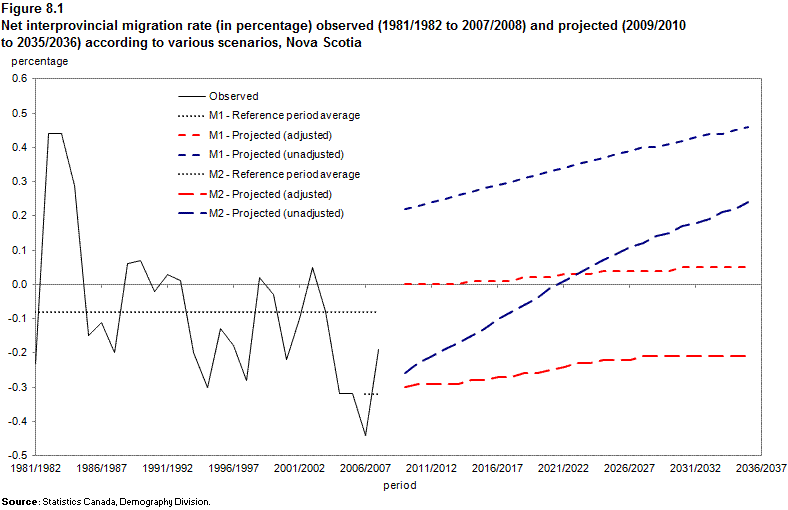
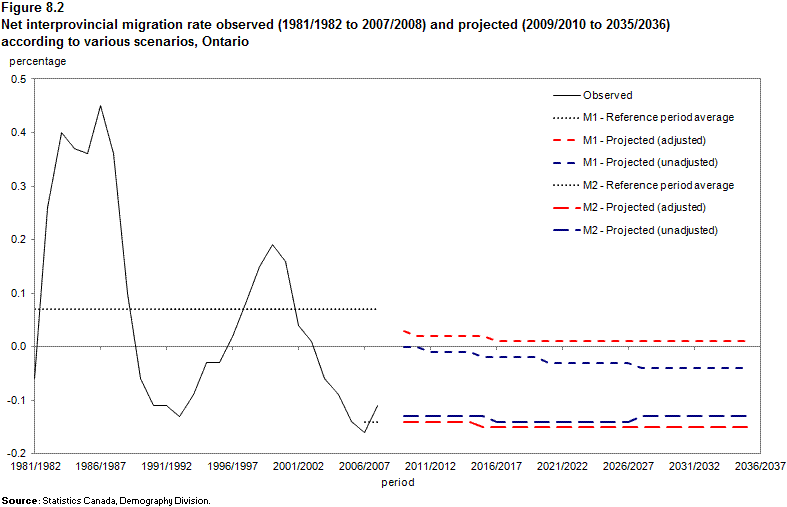
Assumptions
The various interprovincial migration assumptions differ in their reference periods. Each of these references periods reflects a different context, marked notably by particular labour market conditions in the provinces and territories, which have been shown to greatly influence interprovincial migration patterns (Finnie 2000; Bernard et al. 2008). Together, these assumptions illustrate the high volatility of this component over time.Note 7
Five projection assumptions were developed, for the express purpose of presenting a wide range of scenarios for each province and territory. The 1991/2011 period was selected for the scenario that is traditionally referred to as ‘historical’ because it is a relatively long period (20 years) and it is the longest period for which data are available for all provinces and territories (following the creation of Nunavut).
The alternative scenarios reflect shorter periods within the 1991/2011 range. The reference periods were selected in such a way that a most favourable scenario and a least favourable scenario could be identified for each province and territory. To that end, the first and third quartiles of the annual net migration rates for the 1991/2011 period were taken as targets for the low-growth and high-growth migration assumptions respectively.Note 8, Note 9 Table 8.1 shows the quartiles of the average annual net migration rates observed during the 1991/2011 period and the net migration rates observed during the various reference periods associated with the assumptions. With the new model for projecting interprovincial migration used in this edition, the projected average net migration rates will remain closer to the rates observed during the reference periods associated with the various scenarios, which was not the case in previous editions.
Assumption M1 (historical)
Assumption M1, which can also be referred to as the historical assumption, is based on the longest reference period, from 1991/1992 to 2010/2011. Under this assumption, only Alberta and British Columbia experience positive net migration (Figure 8.3), while Prince Edward Island and Ontario experience close to zero net migration.
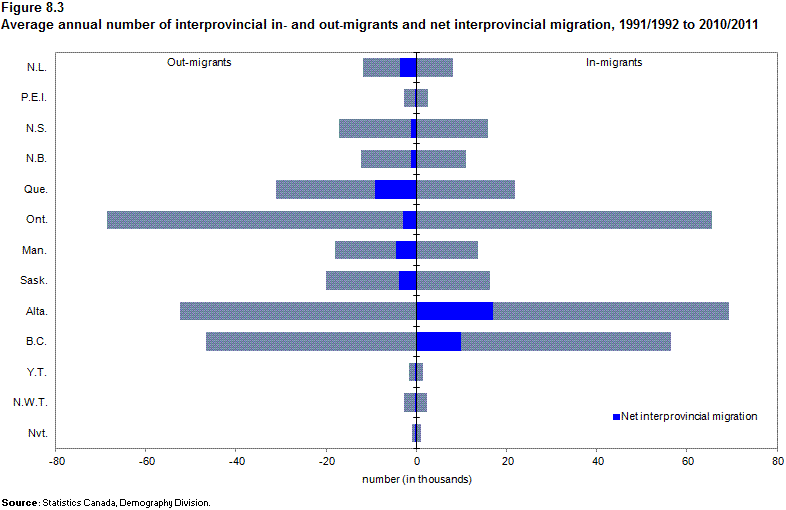
Assumption M2
Assumption M2 reflects the period 1991/1992 to 1999/2000. Of all the assumptions presented, it is the most favourable to Prince Edward Island and British Columbia and the least favourable to Newfoundland and Labrador, Quebec and Yukon (Figure 8.4).
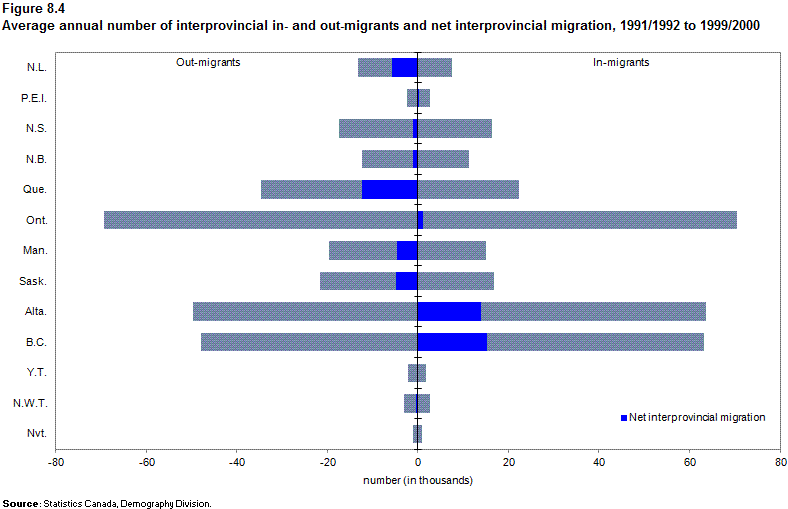
Assumption M3
Assumption M3 is based on a brief four-year period, 1999/2000 to 2002/2003, in which Saskatchewan and British Columbia had particularly disadvantageous net migration figures (Figure 8.5). In contrast, assumption M3 features the largest migration gains for Ontario and the smallest losses for the Northwest Territories (the latter experiences negative net migration in every migration assumption).
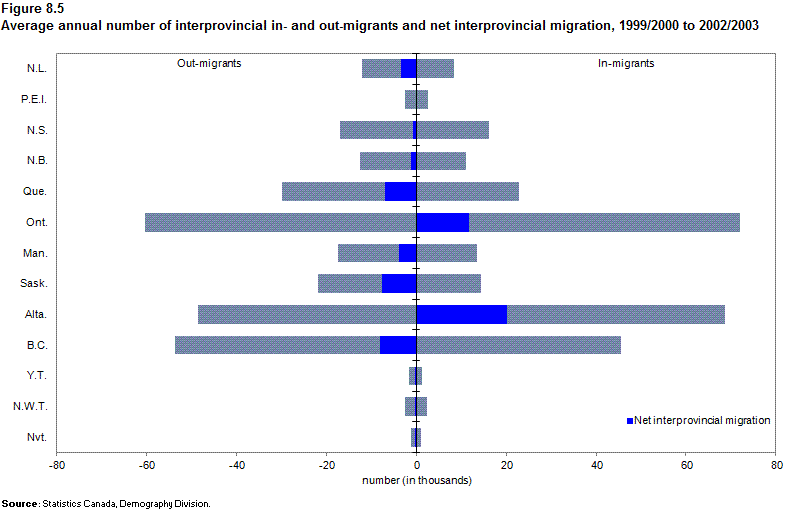
Assumption M4
Assumption M4 is based on the period 2004/2005 to 2007/2008, which is characterized by migration flows that were particularly advantageous to Alberta (Figure 8.6). The flows to Alberta largely account for the fact that various provinces and territories (Prince Edward Island, Nova Scotia, New Brunswick, Ontario, Manitoba and Nunavut) experienced their most disadvantageous net migration figures in this assumption.
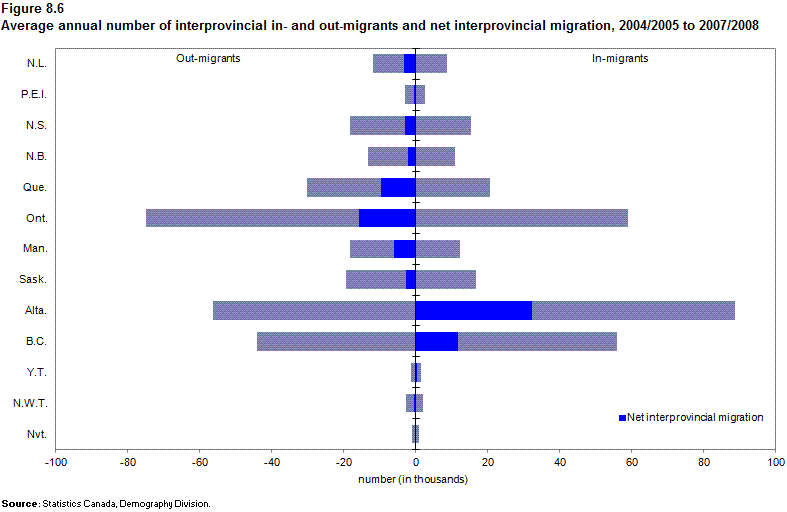
Assumption M5
Assumption M5 reflects the period 2009/2010 to 2010/2011 and can be described as the ‘recent trends’ assumption. Though brief, this period reflects substantial changes in the general trends observed in Canada. First, migration to Alberta diminished appreciably in intensity, to the point where the province’s net migration, though positive, was at its lowest (Figure 8.7). Second, provinces that typically had negative net migration, such as Newfoundland and Labrador, Nova Scotia, New Brunswick and Saskatchewan, experienced gains. While Manitoba had a net migration loss, this was the least disadvantageous scenario for the province. In addition, assumption M5 had the largest migration gains for Yukon and Nunavut.
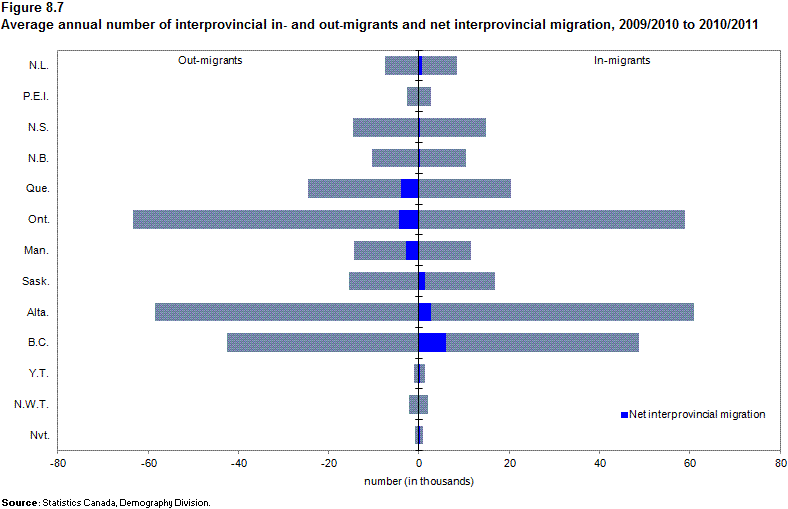
References
Bernard, A. R. Finnie and B. St-Jean. 2008. “Interprovincial mobility and earnings”, Perspectives on Labour and Income, volume 9, number 10, Statistics Canada Catalogue no. 75-001-X.
Bohnert, N. 2013. “Migration: Interprovincial, 2009/2010 and 2010/2011”, Report on the Demographic Situation in Canada, Statistics Canada Catalogue no. 91-209-X.
Courgeau, D. 1991. “Perspectives avec migrations”, Population, volume 46, issue 6, pages 1,513 to 1,530.
Dion, P. 2012. "Evaluating population projections: Insights from a review made at Statistics Canada", preliminary version, paper presented at the Annual meeting of the Population Association of America, San Francisco, May 4, 2012, available at: http://paa2012.princeton.edu/papers/122233.
Dion, P. and S. Coulombe. 2008. “Portrait of the mobility of Canadians in 2006: Trajectories and characteristics of migrants”, Report on the Demographic Situation in Canada, 2005 and 2006, Statistics Canada Catalogue no. 91-209-X.
Feeney, G. 1973. “Two models for multiregional population dynamics”, Environment and Planning, volume 5, pages 31 to 43.
Finnie, R. 2000. "Who moves? A panel logit model analysis of inter-provincial migration in Canada", Analytical Studies Branch, research paper no. 142, Statistics Canada Catalogue no. 11F0019MPE.
Isserman, A. 1992. “The right people, the right rates: Making population estimates and forecasts with an interregional cohort-component model”, Research Paper 9216, West Virginia University, available at: http://www.rri.wvu.edu/pdffiles/wp9216.pdf.
Le Bras, H. 2008. The Nature of Demography, Princeton University Press, New Jersey, 362 pages.
Pittenger, D.B. 1978. “On making flexible projections of age-specific net”, Environment and Planning A, volume 10, pages 1,253 to 1,272.
Plane, D.A. 1982. “An information-theoretic approach to the estimation of migration flows”, Journal of Regional Science, volume 22, issue 4, pages 441 to 456.
Plane, D.A. 1993. “Requiem for the fixed-transition probability migrant”, Geographical Analysis, volume 25, pages 211 to 223.
Plane, D.A. and P.A. Rogerson. 1994. The Geographical Analysis of Population with Applications to Planning and Business, New York, Wiley, 418 pages.
Poulain, M. 1982. "L'analyse spatiale d'une matrice de migration interne : l'exemple des migrations interprovinciales de six provinces du Canada pour les périodes 1956-1961, 1966-1971 et 1971-1976�, Cahiers québécois de démographie, volume 11, issue 1, pages 47 to 68, available at: http://id.erudit.org/iderudit/600868ar.
Rogers, A. 1990. “Requiem for the net migrant”, Geographical Analysis, volume 22, issue 4, pages 283 to 300.
Smith, S.K. 1986. “Accounting for migration in cohort-component projections of state and local populations”, Demography, volume 23, issue 1, pages 127 to 135.
Vanderkamp, J. 1976. “The role of population size in migration studies”, The Canadian Journal of Economics, volume 9, issue 3, pages 508 to 517.
Werschler, T. and F. Nault. 1996. “Projecting interregional migration balances within a multiregional cohort-component framework”, Environment and Planning A, volume 58, pages 769 to 782.
Wilson, T. and M. Bell. 2004. “Comparative empirical evaluations of internal migration models in subnational population projections”, Journal of Population Research, volume 21, issue 2, pages 127 to 160.
Wilson, T. and P. Rees. 2005. “Recent developments in population projection methodology: A review”, Population, Space and Place, volume 11, pages 337 to 360.
Notes
- Date modified:
